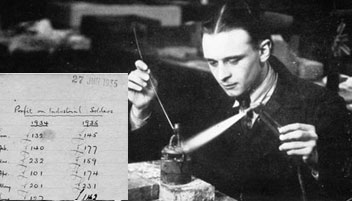Our History

1900 - An approved refiner to the Bank of England, 'Johnson Matthey & Company' is also involved in the manufacture of precious metal products. At around 1903 the Company installs new rolling and melting facilities at its premises in Hatton Garden, London and starts to produce experimental silver solders for its silversmith customers. These first solders were made by adding the 'best brass' drapers pins to a melt of silver thus producing silver-copper-zinc solders.
1910 - Johnson Matthey's involvement in metal joining is extended with the supply of carat gold solders for goldsmiths. Records show that the Company was now also manufacturing a range of silver 'solders' for its customers in the West End. By the end of the decade solders are supplied through its branches in London, Birmingham and Sheffield.

1930 - In the early 1930's the Company begins to develop technology to exploit the growing number of industrial uses for silver. In 1932 JM signs a licence with Handy and Harman of America and begins to market the 'Sil-fos™' and 'Easy-flo™' brands. Sales grow rapidly in the 1930's, as industrial 'silver brazing' becomes an established process in Europe. The Company's research laboratory develops improved brazing alloys and fluxes including Easy-flo™ No.2 and Easy-flo™ flux powder
1940 - Demand for brazing alloys and electrical contact materials is high during the war years and Johnson Matthey develops many new products. These include a cadmium-free silver brazing alloy required because of concerns over shortages of cadmium. This product later becomes known as Silver-flo™ 55 a filler metal which is now internationally recognised as one of the best cadmium-free brazing products.

1950 - In 1953 Harry Brooker of JM co-writes 'Industrial Brazing' one of the first books on brazing, firmly establishing Johnson Matthey's technical credentials. Also in the latter part of this period Johnson Matthey is among the first companies to establish melt control for its production supported by x-ray and spectrographic analysis. As a consequence Johnson Matthey forges a reputation for the quality of its products.
1960 - With the emergence of furnace brazing techniques Johnson Matthey develops its brazing range launching Orobraze™ and Pallabraze™ products and patenting new alloys such as B-Bronze™. The new gold and palladium based filler metals are used in the manufacture of vacuum tube devices and aero-engine components. Important research on the effects of impurity levels of refractory elements is published (M. Sloboda).

1970 - With increasing awareness of the potentially harmful effects of cadmium oxide fume Johnson Matthey develops a broad range of cadmium free brazing filler metals. JM also signs a license agreement to market brazing pastes.
1980 - During the early 80s Johnson Matthey undertakes extensive research into flux compounds and fluxing activity. This work results in a very broad range of fluxes that have become recognized worldwide. Johnson Matthey's European production of brazing products is transferred to its Italian facility in Milan and the contacts and electrical materials business is sold.

1990 - Metal Joining focuses on further development of its product range and technical support. In 1992 the business launches its own range of brazing pastes, pioneering new applications for these products. Whilst in 1994 Metal Joining wins the International Andre Leroy Prize, ‘Best Training Video’, for its production ‘Successful Brazing’. There is further consolidation in production ensuring that the business remains strong.
2000 - Coming ‘full-circle’ Johnson Matthey successfully re-enters the jewellery solder market launching a range of solders for gold and platinum soldering. The business is very different today serving high-tech industries like aerospace and specialised tool manufacturing. Development of new brazing filler metals continues and current projects include a new ‘super’ tri-foil for arduous applications as well as a new palladium bearing brazing filler metal.

With critical applications, from industries such as aerospace, oil and gas drilling, medical and automotive, becoming more important Johnson Matthey Metal Joining gears up for obtaining AS9120 Quality Management System. We hope to achieve this in 2015.
We have also embarked on a research project with the University of Sheffield utilising the resources of the Materials Science Department and a PhD Researcher.


